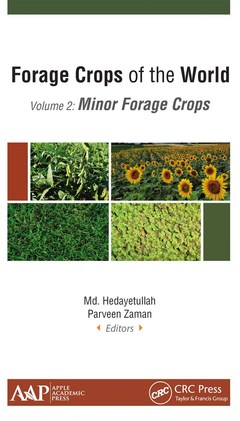Description
Forage Crops of the World, Volume II: Minor Forage Crops
Coordinators: Hedayetullah Md., Zaman Parveen
Language: English
Subjects for Forage Crops of the World, Volume II: Minor Forage Crops:
Keywords
Pest; GREEN FODDER YIELD; Bidhan Chandra Krishi Viswavidyalaya; Downy Mildew; Soil Fertility; Rhodes Grass; Tamil Nadu; Yellow Mosaic; Moisture Content; Deep Red; Nitrogen Free Extract; Green Fodder; Sowing Time; Powdery Mildew; NEH Region; Mungbean Yellow Mosaic Virus; Digitaria Eriantha; Urd Bean; Herbage Yield; Neem Oil; PSB; Mold Board; Bemisia Tabaci; Regional Research Station; Small Seeded Types
Publication date: 03-2021
Support: Print on demand
Publication date: 11-2018
· 15.2x22.9 cm · Hardback
Description
/li>Contents
/li>Biography
/li>
This book, the second of two volumes, discusses the importance of fodder production of the minor fodder crops for animals. It focuses on 25 minor forage crops, including non-leguminous perennial forages, leguminous forages, and non-graminaceous forages. It discusses crop production methodology and agronomic management in a systemic way, providing an abundance of information on each type of forage crop discussed, including preferred soil type, land capability, cropping patterns, climate, and socioeconomic conditions. It goes on to address pests, disease management, agroforestry in fodder and forage crops, preservation, and production and climate change.
This volume provides valuable information needed for effective forage crop production and management. The book, with chapters from highly qualified scientists, will be a rich resource for researchers, academicians, students, and those in the industry. Forage Crops of the World, Volume I: Major Forage Crops focuses on major forage crops.
Key features:
? Discusses 25 different types of minor forage crops, including many types of grasses and other plants
? Provides information on agronomic production practices
? Covers pest and disease management practices for forage crops
Setaria Grass (African Grass). Para Grass (Buffalo Grass). Doob Grass (Bermuda Grass). Marvel Grass (Diaz Blue Stem). Pangola Grass (Digit or Woolly Finger Grass). Canary Grass (Harding Grass). Anjan Grass (African Foxtail Grass). Rhodes Grass (Abyssinian Rhodes Grass). Grass Pea (Indian Vetch). Moth Bean (Dew Bean). Soybean (Bhatman). Fenugreek (Greek Clover). Senji (Sweet Clover). Mung Bean (Green Gram). Urd Bean (Black Gram). Sunflower (Sujyomukhi). Brassicas. Turnip (Salgam). Gajar (Carrot). Amaranthus (Pigweed). Subabul (River Tamarind). Gliricidia (Quickstick). Khejri (Prosopis). Non Conventional Legumes Forage Crops. Azolla: An Unconventional Forage Crop. Disease Management of Non-Leguminous and Non-Graminaceous Forages.
Md. Hedayetullah, PhD, is an Assistant Professor/Scientist and Officer In-Charge, All India Coordinated Research Projects on Chickpea, Directorate of Research, Bidhan Chandra Krishi Viswavidyalaya, Kalyani, Nadia, West Bengal. He is a former Agronomist with the NABARD, Balasore, Odisha, India. He was also formerly a Professor at the M.S. Swaminathan Institute of Agriculture Science, Centurion University of Technology and Management, Gajapati, Odisha, India, and an Assistant Professor at the College of Agriculture, Tripura, India. Dr. Hedayetullah is the author and co-author of research papers, review papers, book chapters, and one book. He was awarded the Maulana Azad National Fellowship Award from the University Grant Commission, New Delhi, India, and received several fellowship grants from various funding agencies to carry out his research work during his academic career.
Parveen Zaman, PhD, is an Assistant Director of Agriculture (Farm) at the Pulse & Oilseed Research Sub-Station, Beldanga, Department of Agriculture, Government of West Bengal, India. She is the author and co-author of several research papers, review papers, and book chapters. She acquired her BS degree (Agriculture), receiving a Gold Medal, from Bidhan Chandra Krishi Viswavidyalaya, Mohanpur, Nadia, West Bengal, India. She received her MS degree (Agronomy), also with Gold Medal, from Bidhan Chandra Krishi Viswavidyalaya, Mohanpur, Nadia, West Bengal, India. She was awarded the Maulana Azad National Fellowship Award from the University Grants Commission, New Delhi, and has received several fellowship grants from various funding agencies to carry out her research work during her academic career.




